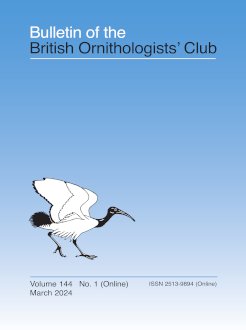Markham's Storm Petrel Hydrobates markhami is typically found in pelagic waters off Chile, Peru and rarely Ecuador. We report an exceptional record of a grounded fledgling in La Paz, Bolivia, far from its usual habitat and range, possibly as a result of storms or other climatic factors, >300 km from the nearest breeding colonies in northern Chile. The species breeds in the Atacama Desert, with the young flying west to the sea on fledging, but young of other seabirds can become lost due to relatively poorly understood factors, such as light pollution and, more uncommonly, even human intervention. This is the first record of the species in Bolivia and one of the first records of any Procellariform in the country.
Markham's Storm Petrel Hydrobates markhami is a seabird confined to the Humboldt Current, including the waters off Chile, Peru and rarely Ecuador (Jahncke 1993, Barros et al. 2019, Medrano et al. 2021). It is characterised by almost uniformly dark appearance, distinctive diagonal markings on the upperwings and a forked tail. The similar Black Storm Petrel H. melania has pale bars on the upperwings that extend to the carpal (Schulenberg et al. 2007).
Reproductive phenology varies between colonies, and even among pairs at a single colony (Barros et al. 2019). Approximately six colonies are known in northern Chile (five in Arica-Parinacota and one in northern Tarapacá). These colonies initiate breeding in April and conclude with fledglings in December. Further south in Tarapacá, two other colonies (Pampa la Perdiz and Salar Grande) commence breeding in November and conclude in May (Torres & Lemus 2013, Barros et al. 2019). Timing at the colony in Paracas, Peru coincides with the colonies of Arica-Parinacota (Jahncke 1993). The species breeds in burrows and crevices within nitrate deposits in the Sechura and Atacama deserts, usually up to 25 km from the coast (Jahncke 1993, Barros et al. 2019, Medrano et al. 2019). The crevices vary in size and depth, and some are on small hills rather in level ground (Medrano et al. 2021). Even within colonies there is no synchrony among pairs (Barros et al. 2019).
On 10 January 2023, a Markham's Storm Petrel was brought to the rehabilitation centre Amor por los Animales Bolivia (APLAB) in La Paz (Fig. 1), but died hours later. It had been found by a student from the Universidad Católica in a garden in the Obrajes urban area of La Paz. The bird was handled in accord with biosecurity measures against avian influenza, which was prevalent at the time, and has been deposited in the Colección Boliviana de Fauna, Museo Nacional de Historia Natural, La Paz, CBF 5651 (Fig. 2). This is the first record of H. markhami for Bolivia.
The individual was a female, mass 32.7 g, with granulated ovules, oviduct with a mean length of 19.73 mm, a medium-sized ovary measuring 4.61 × 1.95 mm and minuscule ovules. The skull was 5% ossified, indicating that it was a recent fledgling; there was no evidence of moult and it had limited body fat. The bill, tarsus and toes were black. Orange liquid was found in its stomach. Total body length 200 mm; wingspan 483 mm; wing length 176 mm; tail averaged 98.63 mm. Additionally, we observed that it had downy feathers in the abdominal region, a characteristic indicative of recent fledglings.
Figure 1.
Markham's Storm Petrel Hydrobates markhami found at the Catholic University in La Paz, Bolivia, January 2023 (Ana Serrano R.)

Figure 2.
The same individual of Markham's Storm Petrel Hydrobates markhami prepared as a study skin and deposited in the Colección Boliviana de Fauna, Museo Nacional de Historia Natural, La Paz, Bolivia, CBF 5651 (Nicole A. Avalos)

This record is c.310 km from the breeding grounds in Arica (Torres & Lemus 2013) and c.930 km from Paracas. There are reports from the Panama Bight and even Baja California (Spear & Ainley 2007), with one 85 km inland in the Pica area of Chile (Johnson 1965). Similarly, one was reported 145 km inland in the Chuquicamata area of Chile (Demetrio 1993). Individuals have also been recorded at 3,800 m in the Jangas district of Peru, 90 km from the coast (Medrano et al. 2021). There are reports outside their range of other pelagic species that share the same waters, e.g., a Hornby's Storm Petrel Hydrobates hornbyi at Bariloche, Argentina ( https://ebird.org/checklist/S67920491), c.200 km from the Chilean coast.
To explain how the Markham's Storm Petrel reached La Paz, there are two possible hypotheses. The first (a) is that the young bird could have become disoriented or become lost due to an unknown natural phenomenon, for example light pollution. Individuals from the Arica colonies are known to vacate the breeding sites between January and April (Barros et al. 2019), with the current record in January. The second hypothesis (b) is that it was transported by humans. There is heavy traffic between Arica and La Paz due to tourism and transportation of goods. There is a possibility that someone in Arica found this individual stranded, and picked it up with the intention of taking care of the bird. On reaching La Paz, they may have decided to release the bird in a garden, not knowing what to do with it, as most local people are unsurprisingly not familiar with seabirds. For now, we cannot confirm or eliminate either hypothesis. This is the first record of the species in Bolivia and one of the first of any Procellariform species in the country.
Acknowledgements
We express our appreciation to Anahí Paca for her assistance during the preparation of the individual, and to Fabián Beltrán for providing personal protective equipment to do this. Likewise, we acknowledge the reviewers, one anonymous, Fernando Medrano Martinez, and Guy Kirwan, for their contributions to the manuscript.
© 2024 The Authors
This is an open-access article distributed under the terms of the Creative Commons Attribution-NonCommercial Licence, which permits unrestricted use, distribution, and reproduction in any medium, provided the original author and source are credited.






